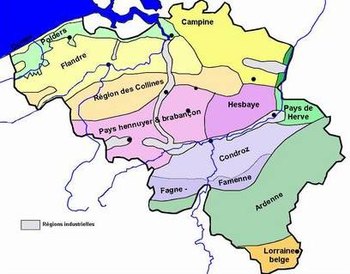Famenne

Famenne is a natural region in southern Belgium. Together with The Fagne or la Fagne, west of the river Meuse, it is part of the Fagne-Famenne natural region. The two regions are often grouped together because they are quite similar both geographically and naturally.
Etymology
The name Famenne may derive from the Paemani, a Germanic tribe, following the influence of the Germanic sound shift from 'p-' to 'f-'.[1]
Geography
Natural geography
Famenne is mostly in the provinces of Namur and Luxembourg in Wallonia in southern Belgium. Its northeastern tip extends into the province of Liège. It is bounded on the west by the river Meuse, west of which lies Fagne, similar to Famenne both geographically and naturally.[2] To the north of both lies the Condroz natural region. Famenne is at the western edge of the Ardennes mountain range.
Famenne is traversed by the Calestienne, a band of limestone resulting in calcium-rich soil and a corresponding concentration of calcicole plants. The rivers Lesse and Lomme cross the Calestienne, forming substantial cave systems. The caves of Han-sur-Lesse, the caves of Hotton and Rochefort's Lorette cave are the most notable examples.
Human geography
The most important city and unofficial capital of Famenne is Marche-en-Famenne. Other towns include Beauraing, Rochefort, Hotton and Durbuy.
Economy
The agriculture and forestry sectors are the main sources of employment in the region, although tourism also plays an important role.
References
- ^ Busse 2006, p. 199.
- ^ Fagne." Encyclopædia Britannica. 2010. Encyclopædia Britannica Online. 9 August 2010.
50°16′N 5°24′E / 50.26°N 5.4°EBibliography
- Busse, Peter E. (2006). "Belgae". In Koch, John T. (ed.). Celtic Culture: A Historical Encyclopedia. ABC-CLIO. pp. 195–200. ISBN 978-1-85109-440-0.
- Use dmy dates from July 2013
- Natural regions of Belgium
- Areas of Belgium
- Forestry in Belgium
- Wetlands of Belgium
- Geographical, historical and cultural regions of France
- Forestry in France
- Wetlands of Metropolitan France
- Regions of Wallonia
- Landforms of Wallonia
- Landforms of Liège (province)
- Landforms of Luxembourg (Belgium)
- Landforms of Namur (province)
- Landforms of Ardennes (department)
- Marche-en-Famenne
- Famennian
